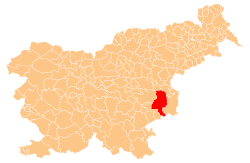Krško
Krško (pronounced [ˈkə́ɾʃkɔ] (![]()
Krško Videm–Krško (1953–1964) | |
|---|---|
 | |
 Krško Location of the Town of Krško in Slovenia | |
| Coordinates: 45°57′N 15°29′E | |
| Country | |
| Traditional region | Lower Carniola |
| Statistical region | Lower Sava |
| Municipality | Krško |
| Area | |
| • Total | 6.00 km2 (2.32 sq mi) |
| Elevation | 163 m (535 ft) |
| Population (2020) | |
| • Total | 7,217 |
| • Density | 1,200/km2 (3,100/sq mi) |
| Time zone | UTC+01 (CET) |
| • Summer (DST) | UTC+02 (CEST) |
| Postal code | 8270 |
| Website | www |
Slovenia's only nuclear power plant, the Krško Nuclear Power Plant, lies southeast of the town.[4]
Name
The name of the settlement was changed from Krško to Videm–Krško in 1953. The name Krško was restored in 1964.[5][6][7][8] In the past the German name was Gurkfeld.[2]
History
Archaeological evidence shows that the area was settled in prehistoric times. Along the Sava River, numerous Bronze and Iron Age sites as well as Roman finds show continuous occupation. After the Medieval period the area was a Habsburg possession. It was affected by Ottoman raids from the 15th to the 17th centuries.
Mass grave
Krško is the site of a mass grave associated with the Second World War. The Bunker Mass Grave (Slovene: Grobišče v zaklonišču) is located on the steep right bank of the Sava River, opposite the municipal headquarters, 50 meters (160 ft) north of the house at Bohoričeva 4, and 100 meters (330 ft) south of a school playground. It contains the remains of more than 100 Croatian civilians that were murdered and then hidden in a dynamited bunker.[9]
Main sights
The Krško parish church in the town centre is dedicated to John the Evangelist and belongs to the Roman Catholic Diocese of Novo Mesto. It is an originally late 15th-century building that was largely rebuilt in 1899.[10] A second parish is the Parish of Videm-Krško in the southern part of the town. Its parish church is dedicated to Saint Rupert. It was built from 1893 to 1897 in the Neo-Romanesque style. The church in the hamlet of Stara Vas (German: Altendorf),[11] dedicated to Saint Michael, belongs to this parish. It was built in 1768 to replace an older structure.[12] The church on the right bank of the Sava is dedicated to the Holy Spirit and was built in 1777 according to plans by the Austrian architect Johann Nepomuk Fuchs.[13]
The Capuchin monastery with its church is in the centre of town on the right bank of the Sava. It was built from 1640 to 1644 and was altered at various stages in its history.[14]
Prominent residents
South of Holy Spirit Church is a town house built in 1607 in which the 17th-century scholar Johann Weikhard von Valvasor lived the final years of his life. He died there in 1693. Other important figures in Slovene history linked with Krško are Adam Bohorič, a grammarian and early schoolmaster, born in Brestanica in 1520, and his pupil Jurij Dalmatin,born in Krško around 1547 who, by 1578, had translated the entire Bible into Slovene (published in 1583).
- Robert Beric, footballer
Economy
Industries of Krško include construction, metalworking, paper, textiles, wood processing, agriculture, trade, and transportation, while tourism continues to develop.
See also
References
- "Slovenski pravopis 2001". Retrieved 25 March 2015.
- Leksikon občin kraljestev in dežel zastopanih v državnem zboru, vol. 6: Kranjsko. Vienna: C. Kr. Dvorna in Državna Tiskarna. 1906. p. 76.
- Krško municipal site
- Krško Nuclear Power Plant site
- Spremembe naselij 1948–95. 1996. Database. Ljubljana: Geografski inštitut ZRC SAZU, DZS.
- Sebanc, Miško. 2012. Gospodarski razvoj v Občini Krško od sredine 19. stoletja. Bachelor's thesis. Ljubljana: University of Ljubljana, Faculty of Arts, Department of Geography and Department of History, p. 3. (in Slovene)
- Medved, Drago. 2006. Krško. Turistično spoznavanje kulturnozgodovinskih dragocenosti občine. Krško, Občina Krško, p. 15. Archived 2014-06-06 at the Wayback Machine (in Slovene)
- Razširjeni seznam sprememb naselij od 1948 do 1964: preimenovanja, združevanja, odcepitve, pristavki, razglasitve in ukinitve. 1965. Ljubljana: Zavod SR Slovenije za statistiko, p. 52.
- Ferenc, Mitja (December 2009). "Grobišče v zaklonišču". Geopedia (in Slovenian). Ljubljana: Služba za vojna grobišča, Ministrstvo za delo, družino in socialne zadeve. Retrieved April 18, 2020.
- Slovenian Ministry of Culture register of national heritage Archived July 12, 2010, at the Wayback Machine reference numbers 1950
- Leksikon občin kraljestev in dežel zastopanih v državnem zboru, vol. 4: Štajersko. Vienna: C. Kr. Dvorna in Državna Tiskarna. 1904. p. 10.
- Slovenian Ministry of Culture register of national heritage Archived July 12, 2010, at the Wayback Machine reference numbers 3485 & 3486
- Slovenian Ministry of Culture register of national heritage Archived July 12, 2010, at the Wayback Machine reference number 305
- Slovenian Ministry of Culture register of national heritage Archived July 12, 2010, at the Wayback Machine reference number 10286
External links
| Wikimedia Commons has media related to Krško. |
- Krško municipal website (in Slovene)
- Krško on Geopedia
